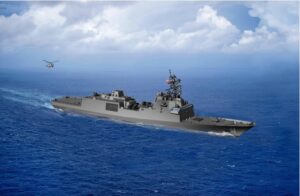The Defense Department’s weapons tester did not approve the new Constellation-class (FFG-62) frigate’s approved the anti-air warfare (AAW) test strategy in the overall testing plan because it is “not adequate to determine the operational effectiveness,” according to an annual 2020 report.
In June 2020, the DoD office of the Director, Operational Test and Evaluation (DOT&E) approved the frigate’s Test and Evaluation Master Plan (TEMP), but excluded approving the plan’s strategy for testing the frigate’s AAW mission capability because it is dependent on applying future test results from the upcoming Flight III of Arleigh Burke-class (DDG-51) destroyers. The DOT&E annual report on DoD programs was released earlier this month.

“DOT&E did not approve the AAW test strategy because it was not adequate to determine the operational effectiveness of the FFG-62 Constellation-class combat system,” the report said.
The Navy’s proposed AAW strategy aims to leverage the results of the Arleigh Burke-class Flight III Aegis-related future test programs to evaluate FFG-62 AAW capabilities because the service insists on similarities between both ships’ combat system.
However, DOT&E is more guarded and said the Navy does “not address how end-to-end mission performance of the DDG 51 Flight III combat system can be extrapolated to evaluate the end-to-end mission performance of the FFG-62 Constellation class combat system.”
The report also warned successful completion of the Navy’s approach depends on successfully managing “substantial test and schedule interdependencies” of at least five distinct acquisition programs that have not yet been documented, resourced, or approved by the DOT&E or Navy in program TEMPs. This includes the Enterprise Air Surveillance Radar, Aegis Weapons System (as installed on DDG 51 Flight III), Standard Missile-2 Block IIIC, Enhanced Sea Sparrow Missile Block 2, and RAM Block 2A/2B.
“The Navy’s proposed AAW approach is not adequate without strategies for managing these interdependencies and addressing end-to-end performance differences between combat systems, and without documentation of critical details on the test scope, assets, resources, and schedule required to support successful test execution,” the report said.
The Navy plans for Aegis testing to be completed by the fourth quarter of fiscal year 2024.
DOT&E said it will work with the Navy to evaluate whether those results ultimately determine if the frigate’s test and evaluation strategy will require unmanned ship testing as well, likely aboard the Navy’s Self Defense Test Ship, the Ex-Paul F. Foster.
“If the requisite data are not available and/or applicable to FFG 62 Constellation class, unmanned ship testing will need to be resourced and scheduled in the Navy’s FY24 TEMP update.”
DOT&E said the Navy is committed to updating the Constellation-class TEMP by the end of FY ’24.
The tester recommended the Navy start working on overall FFG-62 TEMP updates as soon as possible to make sure it is finished by the end of FY ’24. It said the revised TEMP should identify remaining data needed to assess frigate AAW capabilities and “incorporate test events, test assets, and test resources required to complete the evaluation of FFG-62 Constellation class AAW mission capability.”
DOT&E said the updated TEMP should include an overall integrated Master Test Schedule managing the remaining programmatic interdependencies needed for the successful execution of the Navy’s intended AAW operational test strategy.
If the Aegis data is eventually not available or applicable to the Constellation class, the report said the Navy should resource and schedule unmanned ship testing in the FY ’24 TEMP update.
The Navy awarded Fincantieri Marinette Marine a $795 million contract to start building the Constellation-class frigates last April, with options that would rise to $5.6 billion if all 10 planned initial frigates are ordered. The ship design is based on the multi-mission FREMM frigate used by the French and Italian navies (Defense Daily, April 30).